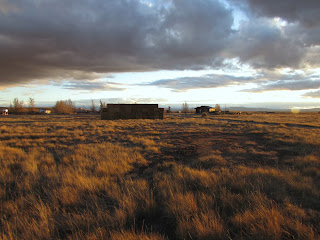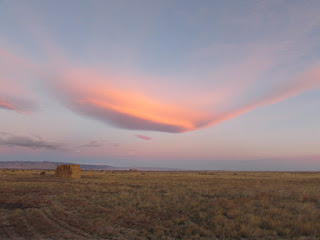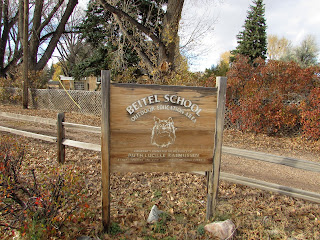Despite the brevity of our visit to Wyoming at the end of October, Stefan and I fell into a routine that allowed us to work out of a kind of rooted-ness. We were as absorbed in our little cabin on the range as much as we were in our short excursions. And we worked well together.
Back at the ranch at the end of our drive to Saratoga on our third and last evening in Wyoming, we carried chairs from the kitchen of our little cabin onto the gravel drive in front. I sat in the westering sun to stay warm and make notes. Stefan set up an easel twenty feet away and began to work with watercolors. It was cold in the shade that grew from every raised surface. But it was quite nice in the sun.
As I wrote I listened to the raucous bellowing of the cattle pastured a half mile away. Their voices are most noticeable near sunrise and sunset.
Leah, our ranch landlord, had said when we arrived on Thursday that it was time for her to begin weaning the calves so we should not be surprised if the bellowing grew more intense. But she hadn't gotten to the weaning yet; other things needed attending first. The bellowing we heard was just end-of-the-day chit-chat, cattle being cattle.
We saw her ride out in the late afternoon several different days to check on the herd. One or more of her dogs always seemed to run ahead of her on their way out, as in this picture, and frequently trotted behind on the way back in.
There were many things we found interesting on the premises, many things to photograph or paint or wonder about in addition to the mountains to the west and to the east. Stefan painted a series of watercolors that brought out the layering of the landscape visible from the kitchen door: grassland, foothills, mountains, horizon, sky, clouds, in gradations of color.
I found the fog that hung over the river beyond the trees in early morning to be particularly telling. It was as if an artificial gap or void had been created between the flat grassland and the highlands that rose into the sky.
One of the things that had attracted our particular attention when we arrived was a large stack of hay bales some one hundred feet from our cabin door. Here it provides a kind of natural border and gives a sense of perspective to the mountains rising in the distances.
The hay bales made an interesting study almost any time of day since they offered both an array of color variations that changed with the sunlight and an assortment of textured surfaces. The cattle who would eventually eat these bales would not have been interested in such distinctions, I am sure, but I was much taken by them if for no other reason than that they seemed to offer in an abstracted way the kinds of color and texture variations one sees in the grassland itself.
Well, perhaps hay bales are an acquired taste. I don't imagine just anyone would find them fascinating or would be patient if they had to wait while someone else photographed or painted the bales; but for us it was engrossing.
When we returned to New York, Stefan incorporated his watercolors and photographs of hay bales with other images and impressions of southeastern Wyoming into the MFA thesis project he had been working on.

Another way of understanding this fascination is to connect it to my family origins in this place. The hay bales, common and unremarkable though they are, have narrative value that resembles the story of our coming and going from Wyoming.
The clouds turned pink before the sun breached the horizon. As it began to appear in the east, the Medicine Bow Range to the west turned pink as well. The clouds shifted from blue-grey to vivid pink to white in a matter of minutes. Once the sun was sending rays across the grassland, a treat in itself, the cloud show was over.
It was a lot to take in in just a handful of days. In short order the sun went down, we took our chairs back into the kitchen, and headed into Laramie to eat. In those few days we felt very much at home in that cabin. Our hosts had afforded us a memorable experience.
The next morning we flew out of the little airport in Laramie in the dark and watched the sun come up at the airport in Denver. We were both sorry to leave so soon, but happy to have gotten out before the snows came.




















































